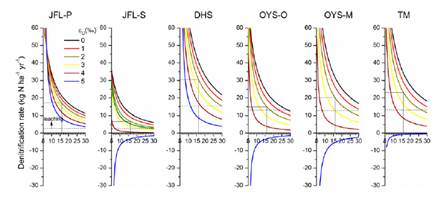反硝化是森林氮损失重要途径
来源:《国家科学院院刊》
作者:方运霆
时间:2015-02-12

反硝化作用是硝态氮还原成氮气的微生物过程,是氮循环中的重要环节。大量化肥使用和化石燃料燃烧等人类活动释放的活性氮大大改变了全球氮循环格局。因此,反硝化作用研究在最近20年受到越来越多的重视。但由于空气氮气含量高,反硝化作用发生的时空变异大,生态系统尺度上的反硝化作用速度量化一直是个巨大挑战。日前,中科院沈阳应用生态研究所在森林反硝化作用速率量化研究方面取得重要进展,相关成果发布在美国《国家科学院院刊》上。
日前,该所研究员方运霆的团队与国内外学者合作,提出了利用硝酸盐氮氧同位素自然丰度技术量化森林生态系统尺度上反硝化作用速率的理论体系,并应用在我国南方和日本中部的6个森林中。
该方法是基于降水、土壤和溪水的硝酸盐氮氧同位素测定,并推算反硝化作用速率。溪水硝酸盐氮氧同位素特征可以综合反映整个森林集水区的硝酸盐沉降、土壤硝酸盐生产(硝化作用)、植物吸收和反硝化作用的最终结果,因此其计算的反硝化作用速率是生态系统水平上的。
研究发现,相关森林生态系统每年每公顷通过反硝化作用的氮损失达到6~30公斤,其损失速度比通过溪水流失的氮还多(每年每公顷2~18公斤),说明土壤气态氮释放是森林生态系统氮损失的重要途径。(来源:中国科学报 彭科峰)
Microbial denitrification dominates nitrate losses from forest ecosystems
Abstract Denitrification removes fixed nitrogen (N) from the biosphere, thereby restricting the availability of this key limiting nutrient for terrestrial plant productivity. This microbially driven process has been exceedingly difficult to measure, however, given the large background of nitrogen gas (N2) in the atmosphere and vexing scaling issues associated with heterogeneous soil systems. Here, we use natural abundance of N and oxygen isotopes in nitrate (NO3−) to examine dentrification rates across six forest sites in southern China and central Japan, which span temperate to tropical climates, as well as various stand ages and N deposition regimes. Our multiple stable isotope approach across soil to watershed scales shows that traditional techniques underestimate terrestrial denitrification fluxes by up to 98%, with annual losses of 5.6–30.1 kg of N per hectare via this gaseous pathway. These N export fluxes are up to sixfold higher than NO3− leaching, pointing to widespread dominance of denitrification in removing NO3− from forest ecosystems across a range of conditions. Further, we report that the loss of NO3− to denitrification decreased in comparison to leaching pathways in sites with the highest rates of anthropogenic N deposition.
原文链接:http://www.pnas.org/content/early/2015/01/15/1416776112.full.pdf+html?with-ds=yes




